Marketers already know the importance of SEO, but building a comprehensive program can be overwhelming and difficult.
With so many businesses jumping into the online space, it might seem futile to dedicate time, money, and resources trying to get on the first page of Google.
If the thought of SEO makes your head hurt, here's a tried and tested step-by-step guide on how to create and execute a killer SEO keyword strategy.
Methodology to Find New Keywords
Using Google's Keyword Tool, you can experiment with finding keywords in two ways:
- Keywords that are relevant to your product offering or service
- Keywords used to find direct and indirect competitors of yours
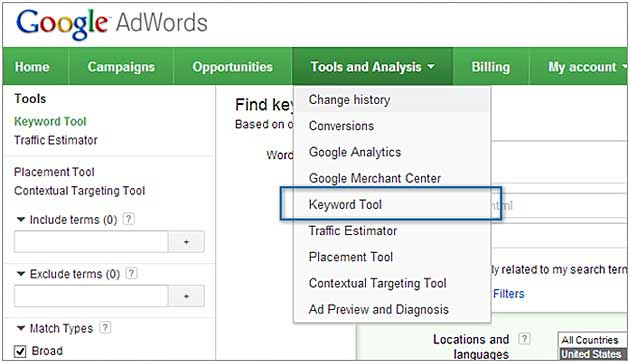
Satisfying No. 1 is based on using a combination of logic, intuition, and looking at existing keyword data from AdWords and Google Analytics. Try thinking "if I were a potential customer who had no knowledge about my company, what would I type into Google search to find the product I'm looking for?"
For example, one possibility for a marketing firm is "content marketing," so you would input that term into the Keywords Tool to analyze its search volume and relevancy to your product offering.
The ideal scenario is to find relevant keywords that have high monthly search volumes and low competition.
You can also narrow down your keyword search based on criteria such as location, type of device, and language to ensure that your keywords relate to your business and target audience.
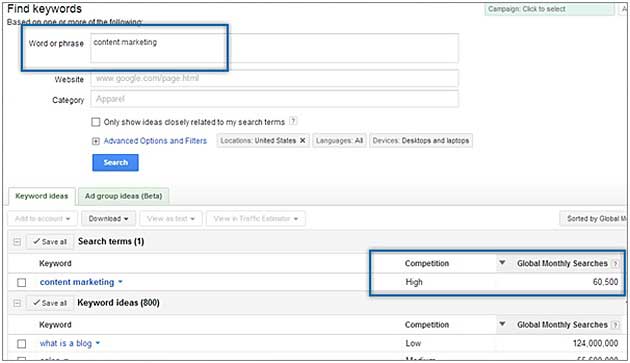
As the example above illustrates, the keyword "content marketing" yields 60,500 Global Monthly Searches and is a high competitive keyword.
Once you determine whether your keyword yields a reasonable volume of Global Monthly Searches, proceed to search the keyword in Google to see how relevant the search results are to your company and product offering.
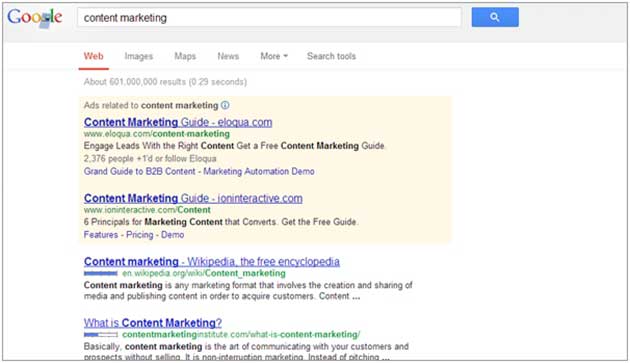
At this stage, simply make a long list of all the relevant keywords that had an adequate search volume.
Repeat this process several times by thinking of keywords that potential customers might use to search for your product.
Another great way of finding relevant keywords is to investigate the Keyword Ideas that are generated by the Google Keyword Tool.
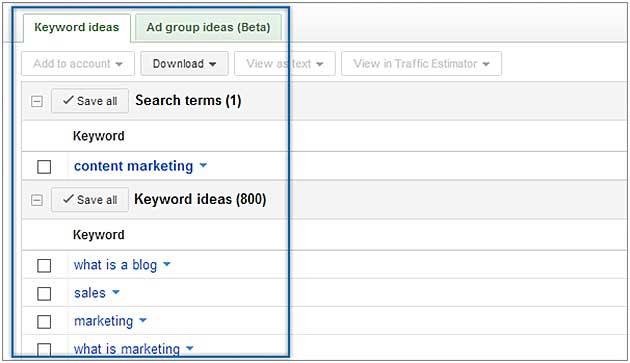
Go through the Keyword Ideas; when you are satisfied with the Global Monthly Search volume, you should then check the relevancy and record the appropriate ones on your master list.
To determine the keywords for No. 2 (keywords that people use to search for and find your competitors), you should search the website source codes of major competitors to see what keywords are listed, and search competitors using the Keywords Tool.
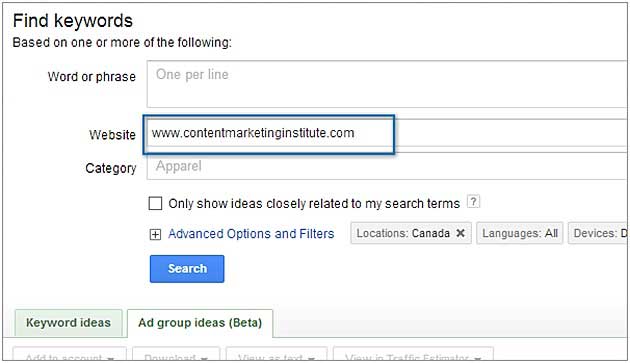
This type of search reveals the keywords people are typing into Google that leads them to find a competitor. You can also type in your own URL to see what keywords people are using to reach your company (notice the subtle difference: in No. 1 you are trying to find relevant keywords that are related to your product but not necessarily ones that you or your competitors are currently listed under. Here, you're finding the keywords that directly lead individuals to competitors or your company).
Determining Your Target Keywords
Once you feel satisfied with your master list, go through it and narrow it down. Choose keywords with the best search volume, relevancy to your product and branding, and minimal competitiveness; also ensure that you don't choose keywords that are too similar to each other.
The Process of Placing Specific Keywords on Website Pages
When your keyword list is finalized, the next step is to place the new keywords into your website pages.
Create an Excel document where you can track which keywords you want to place on each page. Ensure that the top ranking keywords are placed on the most visited pages (as determined by Google Analytics) or on pages that will drive conversions; this is the most logical way to drive up your SEO. You should also make sure that the keywords are logically matched with the website page.
Once this process is complete, go through and reword your website pages to include the new keywords—without making the keywords sound forced. The optimum keyword density is about 1% to 3%; more than that could be considered excessive. Some sentences will need to be rewritten, and some difficult keywords will need creative sentence solutions. For example, if your current sentence reads "turn your blog into an effective medium for lead generation," you should rework the sentence into something like this: "By implementing content marketing strategies, your blog can be an effective medium for lead generation."
The keywords also need to stay in their original form and can't be split up, otherwise the SEO impact will be impaired. For example, "content marketing" is not recognized and indexed by Google the same way as "marketing content," "content marketing services," or any other iteration.
Keywords should be included not only in the main text of your website but also in the metadata: specifically, the title, description, and keyword tags.
* * *
Remember that this process isn't a one-time solution: You need to audit your keywords every few months to ensure that the ones you're targeting haven't changed. In addition, complete your keyword strategy by adding them to your blog pieces (when applicable) and developing a link-building strategy. According to WCC Voice, pages with strong backlinks pointing to them are considered authoritative pages by search engines. Your Page Rank is in part determined by the number and quality of links to your site, so having a strong link building strategy will help increase the popularity of your links and your Google Page Rank.
If you're looking for a comprehensive guide to SEO, check out this great resource by SEOMoz. Also, check out this piece if you're interested in a general overview of SEO.
Do you have any more keyword best-practices? Leave a comment!




